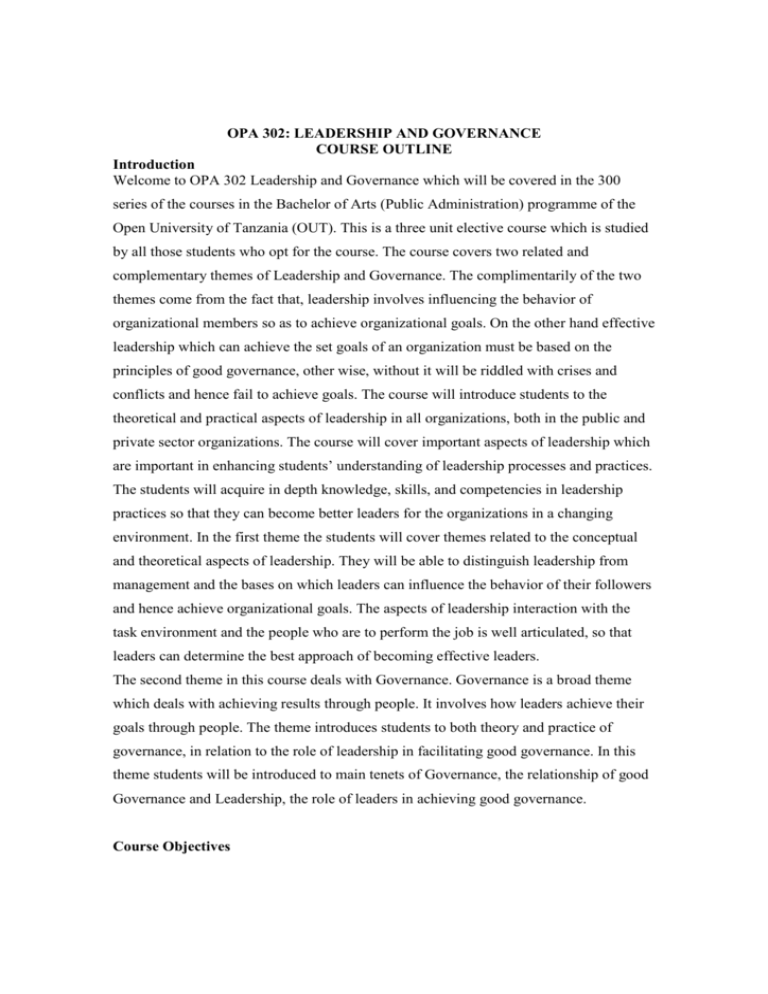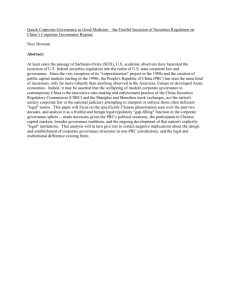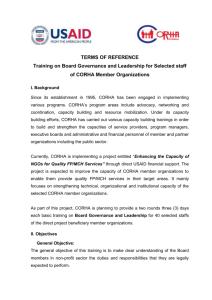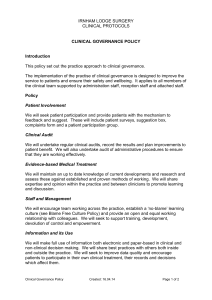
OPA 302: LEADERSHIP AND GOVERNANCE
COURSE OUTLINE
Introduction
Welcome to OPA 302 Leadership and Governance which will be covered in the 300
series of the courses in the Bachelor of Arts (Public Administration) programme of the
Open University of Tanzania (OUT). This is a three unit elective course which is studied
by all those students who opt for the course. The course covers two related and
complementary themes of Leadership and Governance. The complimentarily of the two
themes come from the fact that, leadership involves influencing the behavior of
organizational members so as to achieve organizational goals. On the other hand effective
leadership which can achieve the set goals of an organization must be based on the
principles of good governance, other wise, without it will be riddled with crises and
conflicts and hence fail to achieve goals. The course will introduce students to the
theoretical and practical aspects of leadership in all organizations, both in the public and
private sector organizations. The course will cover important aspects of leadership which
are important in enhancing students’ understanding of leadership processes and practices.
The students will acquire in depth knowledge, skills, and competencies in leadership
practices so that they can become better leaders for the organizations in a changing
environment. In the first theme the students will cover themes related to the conceptual
and theoretical aspects of leadership. They will be able to distinguish leadership from
management and the bases on which leaders can influence the behavior of their followers
and hence achieve organizational goals. The aspects of leadership interaction with the
task environment and the people who are to perform the job is well articulated, so that
leaders can determine the best approach of becoming effective leaders.
The second theme in this course deals with Governance. Governance is a broad theme
which deals with achieving results through people. It involves how leaders achieve their
goals through people. The theme introduces students to both theory and practice of
governance, in relation to the role of leadership in facilitating good governance. In this
theme students will be introduced to main tenets of Governance, the relationship of good
Governance and Leadership, the role of leaders in achieving good governance.
Course Objectives
The student in this course should be able to:
Define the concept Leadership from different perspectives
Describe the major approaches used in the study of Leadership in Organizations
Describe the different Leadership Styles with a view to determining whether there is any
one best style of leadership
Identify the basic elements of effective Leadership
To describe the Leadership Ethics in Organizations
Define the concept of Governance
Identify the basic elements of Governance
Explain the relationship between Leadership and Governance
To discuss the main features of Leadership and Governance in Tanzania
Theme 1: Leadership
Lecture 1: Different conceptions of Leadership and Key components
- Leadership as a process
- Leadership involves influence over others
- Leadership happens within the context of a group
- Leadership involves goal attainment
Lecture 2: Trait Approach to Leadership
- Key attributes of Trait approach to leadership
- Five factor Personality Model and Leadership
- Emotional Intelligence
- How the Trait Approach works
- Strengths and Shortcomings of Trait Approach
Lecture 3: Three Skills Approach to Leadership
- Conceptual skills
- Human skills
- Technical skills
- Skills Model
- Individual attributes
- Leadership outcomes
- Career experiences
- Environmental Influences
- How the Skills Approach model works
- Strengths and shortcomings
Lecture 4: Style Approach to Leadership
- Style approach description
- Ohio state studies
- The University of Michigan studies
- Blake and Mouton’s Managerial Leadership Grid
-
How the style approach works
Strengths and shortcomings
Lecture 5: Situational Approach to Leadership
- Situational approach description
- Leadership styles
- Development levels
- How the Situational Approach works
- Strengths and shortcomings
Lecture 6: Contingency Theory
- Contingency theory description
- Leadership styles
- Situational variables
- How the contingency theory of leadership works
- Strengths and shortcomings
Lecture 7: Path –Goal theory
- Path – Goal Leadership theory description
- Leader Behaviours (directive, supportive, participative and achievement
oriented Leadership)
- Subordinate characteristics
- Task characteristics
- How the P –G leadership theory works
- Strengths and shortcomings
Lecture 8: Leader – Member Exchange Theory (LMX)
- LMX theory description
- Early studies
- Latter studies
- Leadership making
- How LMX theory works
- Strengths and shortcomings
Lecture 9: Transformational Leadership
- Transformational Leadership definition and description
- Transformational leadership and Charisma
- A Model of Transformational Leadership
- Factors identifying Transformational Leadership
-
Transactional Leadership factors
Non leader factors
Other Transformational perspectives
How the Transformational Leadership works
Strengths and shortcomings
Lecture 10: Team Leadership
- Team Leadership description
- Team Leadership Model
- Team Leadership Actions
- Team Effectiveness
- How Team Leadership Model works
- Strengths and shortcomings
Lecture 11: Gender and Leadership
- Gender and Leadership Description
- Gender and Leadership styles
- Gender and Leadership Effectiveness
- The Glass Ceiling (Evidence, motive for removal and explaining Glass
Ceilings)
- Breaking the Glass Ceiling
- Strengths and shortcomings
Lecture 12: Culture and Leadership
- Culture and Leadership description
- Culture defined / other related concepts – ethno - centricism, prejudice etc
- Dimensions of Culture
- Clusters and characteristics of World Cultures
- Leadership Behavior and World clusters (Eastern Europe, Asian, Latin
American, Sub Saharan Leadership Profiles)
- Universally desirable and undesirable Leadership attributes
- Strengths and Shortcomings
Lecture 13: Leadership Ethics
- Ethics and Leadership description
- Ethics defined
- Centrality of Ethics in Leadership in organizations
- Principles of Ethical Leadership
- Strengths and shortcomings
References
Northouse, P.G. (2007). Leadership: Theory and Practice. Sage
Publications, London
Rowe, G.W. & Guerrero, L. (2011). Cases in Leadership. Sage
Publications, London
Donelly, J.H., Gibson, J.L., & Ivancevich, J.M. (1992). Fundamentals of
Management. Irwin, Homewood, IL Boston.
Daft, R.L. (2005). The Leadership Experience
Mumford, M.D. (2006). Pathways to outstanding Leadership: A
Comparative analysis of Charismatic, Ideological and Pragmatic Leaders.
Mahwal, NJ Lawrence Erlbaum.
Watson, C., & Hoffman, L.R. (20040. The Role of Task –related behavior
in the emergence of leaders. Group and Organization Management 29(6)
659 – 685.
Rost, J.C (1999). Leadership for the twenty – first century. New York,
Praeger.
Hickman, G.R (ed) (1998). Leading Organizations: Perspectives for a new
era. Thousand Oaks, CA: SAGE.
Bryman, A. (1992). Charisma and Leadership in Organizations. London:
Sage.
Bass, B.M. (1990). Bass and Sogdills’s handbook of Leadership: A survey
of theory and research. New York: Free Press
Dubrin, A. (2007). Leadership: Research Findings, Practice and Skills.
New York: Houghton Mifflin.
Collins, J. (2004). Level 5 Leadership: The Triumph of humility and fierce
resolve. In Collection of articles – Best HBR on Leadership. Stealth
Leadership pp 15 – 30. Harvard Business School Press.
Northouse, P.G. (2010). Leadership: Theory and Practice 5th ed Thousand
Oaks: CA: Sage.
Yukl, G. (2006). Leadership in Organizations 6th ed. Upper aSaddle River,
NJ: Pearson- Prentice Hall
Zaccaro, S.J., Kemp, C., & Bader, P. (2004). Leader Traits and attributes.
In J. Antonakis, A.T.Cinciolo, & R.J.Sternberg (eds), The Nature of
Leadership pp 101 – 124. Thousand Oaks, CA: Sage
Hofstede, G. (2001). Culture’s Consequences: Comparing values,
behaviours, institutions and organizations across nations. Thousand Oaks,
CA: Sage.
House, R.J., Hanges, P.J., Javidan, M., Dorfman, P.W., Gupta, V. &
Associates (2004). Leadership, culture, and organizations: The Globe study
of 62 societies. Thousand Oaks, CA: Sage.
Phillips, J.R. (2006). CEO Moral Capital. Unpublished Doctoral
Manuscript, University of Western Ontarion.
Kanungo, R.N., & Mendonca, M. (1996). Ethical Dimensions of
Leadership. Thousand Oaks, CA: Sage.
Theme 2: Governance
Lecture 14: Governance defined
Governance – common definitions
Definitions of governance by leading institutions and studies converge on the term as
referring to a process by which power is exercised. More specifically Governance has
been construed to mean different things to different authors as covered here under:
UNDP: Governance is viewed as the exercise of economic, political and administrative
authority to manage a country’s affairs at all levels. It comprises mechanisms, processes
and institutions through which citizens and groups articulate their interests, exercise their
legal rights, meet their obligations and mediate their differences. (UNDP 1997);
World Bank: Governance is defined as the manner in which power is exercised in the
management of a country’s economic and social resources. The World Bank has
identified three distinct aspects of governance: (i) the form of political regime; (ii) the
process by which authority is exercised in the management of a country’s economic and
social resources for development; and (iii) the capacity of governments to design,
formulate, and implement policies and discharge functions. (World Bank, 1997);
OECD: The concept of governance denotes the use of political authority and exercise of
control in a society in relation to the management of its resources for social and economic
development. This broad definition encompasses the role of public authorities in
establishing the environment in which economic operators function and in determining
the distribution of benefits as well as the nature of the relationship between the ruler and
the ruled. (OECD DAC, 1995);
DFID: The Department for International Development adopts the same approach to
governance as that provided by the OECD's Development Assistance Committee (DAC),
which identifies four key elements in governance:
• legitimacy of government (political systems)
• accountability of political and official elements of government (public
administration and financial systems)
• competence of governments to formulate policies and deliver services (public
administration and economic systems, and organizational strengthening)
The DFID believes that the DAC conceptualization is seen to reflect the broad degree of
convergence in bilateral donor thinking on good governance. Since the good governance
agenda has a strong normative content, it has led to calls for an approach more sensitive
to the particular historical contextual realities within recipient countries. An additional
point is the issue of donor governance, highlighted by many host countries.
Asian Development Bank: The definition of governance that is adopted by the ADB is
that provided by the World Bank. Accordingly, the Bank regards good governance as
synonymous with sound development management. It involves both the public and the
private sectors. It is related to the effectiveness with which development assistance is
used, the impact of development programs and projects (including those financed by the
Bank). Thus, irrespective of the precise set of economic policies that find favor with a
government, good governance is required to ensure that those policies have their desired
effect. In essence, it concerns norms of behavior that help ensure that governments
actually deliver to their citizens what they say they will deliver. 42
USAID: Governance encompasses the capacity of the state, the commitment to the public
good, the rule of law, the degree of transparency and accountability, the level of popular
participation, and the stock of social capital. Without good governance, it is impossible to
foster development. No amount of resources transferred or infrastructure built can
compensate for-or survive-bad governance. 43
Institute of Governance, Ottawa: Governance comprises the institutions, processes and
conventions in a society, which determine how power is exercised, how important
decisions affecting society are made and how various interests are accorded a place in
such decisions. (Institute of governance, 2002); Commission on Global Governance:
Governance is the sum of the many ways individuals and institutions, public and private,
manage their common affairs. It is a continuing process through which conflicting or
diverse interests may be accommodated and co-operative action may be taken. It includes
formal institutions and regimes empowered to enforce compliance, as well as informal
arrangements that people and institutions either have agreed to or perceive to be in their
interest. (Commission on good governance, 1995)
Lecture 15: Principles of Good Governance
Participation
Rule of law
Transparency
Responsiveness
Consensus orientation
Equity
Effectiveness and efficiency
Accountability
Strategic vision12
Lecture 16: Relationship between Leadership and Governance
♦ Accountability defined
♦ Forms of Accountability
Horizontal vs Vertical Accountability
Political vs Legal Accountability
Financial Accountability
Moral Accountability
Professional Accountability
Lecture 17: Good Governance and Public Accountability
♦ The Importance of Public Accountability to Governance
♦ Challenges facing Public Accountability
♦ Strategies to Reform Public Accountability and Governance
Lecture 18: Public Accountability and Governance in Tanzania organizations
♦ Institutional approaches to strengthening Public Accountability and
Governance
♦ Obligations to declare wealth and property
♦ Obligations to give information to the Public
Lecture 19: Combating Corruption in Tanzania
Lecture 20: Ethics in Leadership in Public organizations in Tanzania
References:
Hyden, G. & Olowu, D (ed) (2000). Perspectives on Governance. African World Press
Abrahamsen, R. (2000). Disciplining Democracy: Development Discourses and Good
Governance in Africa, Zed Books, London.
Degnbol – Martinussen, J. (2002). Development Goals, Governance and Capacity
Building: Aid as Catalyst. Development and Change vol 33, No 2, 269
URT (2004). Local Government Reform Plan [online] Available at
www.tanzania.go.tz/profile [15th August, 2004]
UNHCR (2004). Good Governance. [online] Available at
www.unhchr.ch/development/gov-01.htm [August 17th 2004]
Sen, Amartya (2000). Development as Freedom, (New York: Alfred A. Knopf, 2000),
p.152.
The World Bank, World Development Report 2003, Sustainable Development in a
dynamic world,
Transforming Institutions , Growth, and Quality of Life. P.1
29 Fukuda-Parr Sakiko and Ponzio Richard, Governance: Past, Present, Future Setting
the governance agenda for the
Millennium Declaration, (Background paper on the HDR 2002).
Holzer Marc & Kim Byong-Joon (ed.), Building Good Governance: Reforms in Seoul,
(National Center for Public Productivity, 2002).
Riviera-Batiz Francisco L., “Democracy, Governance and Economic Growth: Theory &
Evidence”.Paper presented at conference on Democracy, Participation and Development
held in 1999 in New York.
Fukuda-Parr Sakiko and Ponzio Richard, Governance: Past, Present, Future Setting the
governance agenda for the Millennium Declaration, (Background paper on the HDR
2002
st
Graham, John et al. “Principles for Good Governance in the 21 Century,” Institute On
Governance, 2003. P. 3.
Edgar, Laura and Chandler, Jennifer, comps and eds. Strengthening Social Policy:
Lessons on forging government-civil society policy partnerships. Ottawa: Institute On
Governance, 2004.
Ezekiel, Zachariah. “Beyond Bylines: Engaging the News Media in Urban Governance.”
Ottawa: Institute On Governance, 2003.
Frank, Flo and Smith, Anne. “The Partnership Handbook.” Ottawa: Minister of Public
Works and Government Services Canada, 2000.
st
Graham, John et al. “Principles for Good Governance in the 21 Century.” Ottawa:
Institute On Governance, 2003.
Institute On Governance. “Many Voices, One Song: A New Approach to Government
Communications in the Republic of Latvia,” Ottawa, 2001.
Marshall, Claire E. “Governance and the Common Toilet,” Ottawa: Institute On
Governance, 2003.
UNDP (1997). Governance for Sustainable Human Development
Institute of Governance (2002).








